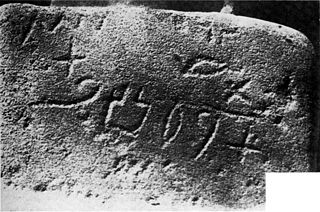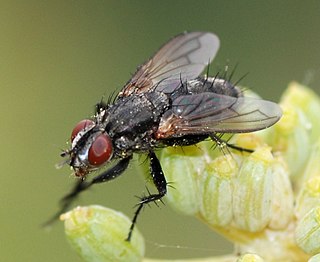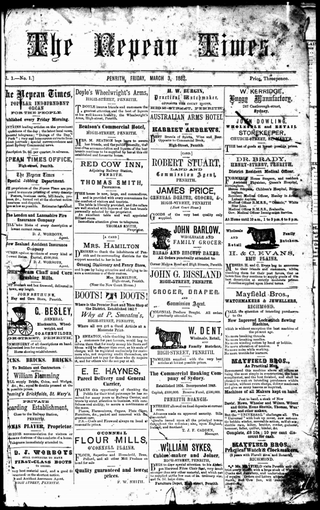Zayin is the seventh letter of the Semitic abjads, including Arabic zāyز, Aramaic zain 𐡆, Hebrew zayīnז, Phoenician zayn 𐤆, and Syriac zayn ܙ. It represents the sound.

The Proto-Sinaitic script is a Middle Bronze Age writing system known from a small corpus of about 30-40 inscriptions and fragments from Serabit el-Khadim in the Sinai Peninsula, as well as two inscriptions from Wadi el-Hol in Middle Egypt. Together with about 20 known Proto-Canaanite inscriptions, it is also known as Early Alphabetic, i.e. the earliest trace of alphabetic writing and the common ancestor of both the Ancient South Arabian script and the Phoenician alphabet, which led to many modern alphabets including the Greek alphabet. According to common theory, Canaanites or Hyksos who spoke a Canaanite language repurposed Egyptian hieroglyphs to construct a different script.

Members of the New South Wales Legislative Council who served in the 54th Parliament were elected at the 1995 and 1999 elections. As members serve eight-year terms, half of the Council was elected in 1995 and did not face re-election in 1999, and the members elected in 1999 did not face re-election until 2007. The President was Meredith Burgmann.

The Nematocera are a suborder of elongated flies with thin, segmented antennae and mostly aquatic larvae. This group is paraphyletic and contains all flies except for species from suborder Brachycera, which includes more commonly known species such as the housefly or the common fruit fly. The equivalent clade to Nematocera is the whole Diptera, with Brachycera as a subclade. Families in Nematocera include mosquitoes, crane flies, gnats, black flies, and multiple families commonly known as midges. The Nematocera typically have fairly long, fine, finely-jointed antennae. In many species, such as most mosquitoes, the female antennae are more or less threadlike, but the males have spectacularly plumose antennae.

The Byblos script, also known as the Byblos syllabary, Pseudo-hieroglyphic script, Proto-Byblian, Proto-Byblic, or Byblic, is an undeciphered writing system, known from ten inscriptions found in Byblos, a coastal city in Lebanon. The inscriptions are engraved on bronze plates and spatulas, and carved in stone. They were excavated by Maurice Dunand, from 1928 to 1932, and published in 1945 in his monograph Byblia Grammata. The inscriptions are conventionally dated to the second millennium BC, probably between the 18th and 15th centuries BC.

Rhinophorinae is a subfamily of flies (Diptera), commonly known as Woodlouse Flies, found in all zoogeographic regions except Oceania, but mainly in the Palaearctic and Afrotropical regions.

The Perissommatidae are a family of flies (Diptera) that was proposed in 1962 by Donald Colless based on the species Perissomma fusca from Australia. The family now includes five extant species within the single genus Perissomma, four from Australia and one from Chile. The Perissommatidae are unusual as they appear to have four compound eyes. They have a small slender body less than 2 mm in length. Their wings are large in comparison to their bodies and subsequently their flight is weak. Preferring high-altitude forest environments, adults only fly in the winter. The larvae live in decaying leaf litter in wet sclerophyll or cool rain forests. Some species are suspected to be associated with fungi. In the case of Perissomma macalpinei, numbers of adults have been observed congregating in clumps of foliage and rising in short, zigzag flights in the sunlight above the foliage for short periods before descending.
Richard Hargrave Colless is an Australian politician. Colless was a member of the New South Wales Legislative Council from 2000 to 2019, representing the National Party.

Anopheles is a genus of mosquitoes (Culicidae) with about 484 recognised species.
Froggattimyia is a genus of parasitic flies in the family Tachinidae.

The Nepean Times was a weekly newspaper first published in the Australian city of Penrith, New South Wales on 3 March 1882.
Anagonia is a genus of flies in the family Tachinidae.

Donald Henry Colless, also known simply as Don Colless, was an Australian entomologist. He was an authority on true flies (Diptera).
The Vela Supercluster (Vela SCl, VSCL) is a massive galactic supercluster about 265.5 megaparsecs (870 million light-years) away within the vicinity of the Zone of Avoidance, centered on the constellation Vela. It is one of the largest structures found in the universe, covering about 25 × 20 degrees of the sky. It consists of two walls: a broad main wall and a secondary merging wall. The combined dimensions of the walls are 115 km/s Mpc on the major dimensions and 90 km/s Mpc on the minor ones, which corresponds to about 385 million and 300 million light years, respectively. It is about 1,000 times the mass of the Milky Way galaxy, which corresponds to a mass of 1 × 1015 M☉. About 20 initial galaxy clusters have been identified spectroscopically.
Australosymmerus is a genus of fungus gnats in the family Ditomyiidae.
John of Dalyatha (c. 690 – c. 780), commonly known as John Saba and in Syriac Yoḥannan, was a monk and mystic of the Church of the East. He spent his entire life in Upper Mesopotamia, alternating between coenobitic (community-based) and eremitic (solitary) monasticism, with a preference for the latter. At the time of his death, he was serving as the abbot of a community of monks.

NGC 540 is a barred lenticular galaxy in the constellation Cetus. It is estimated to be 451 million light years from the Milky Way and has a diameter of approximately 120,000 light years. The object was discovered on October 15, 1885, by the American astronomer Francis Preserved Leavenworth.

Amenia is a genus of flies belonging to the family Calliphoridae.










